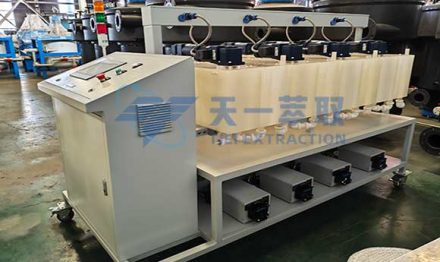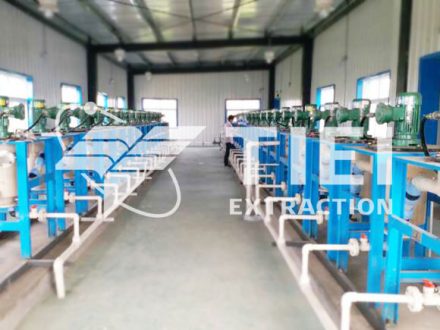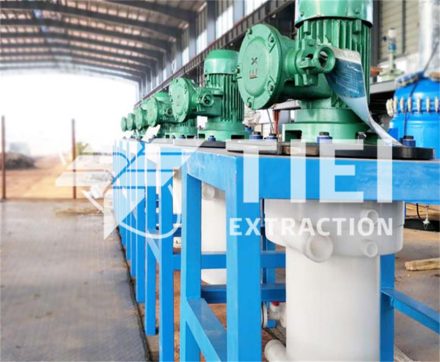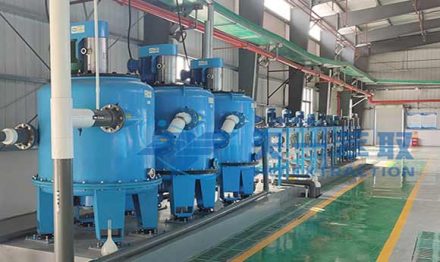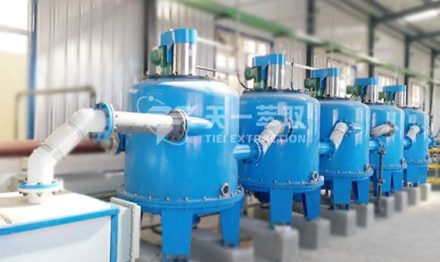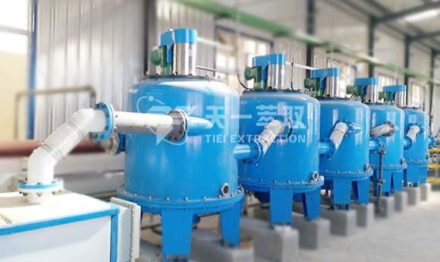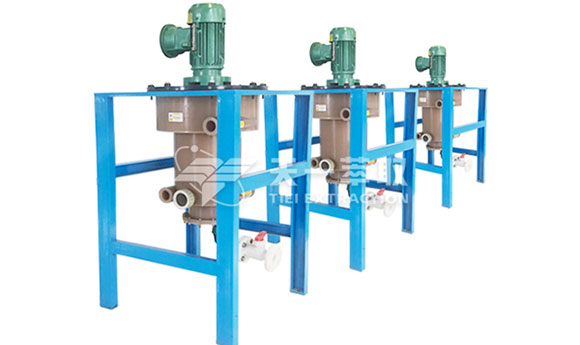
For the extraction of aniline, the most commonly used technology is the liquid-liquid extraction and stripping technology based on its weak alkalinity. By precisely controlling the pH value and utilizing the conversion of aniline between the free base state (soluble in the organic phase) and the ionic state (soluble in the aqueous phase), efficient separation and enrichment recovery from aqueous solution can be achieved. Liquid-liquid extraction technology is particularly suitable for aniline recovery in laboratories and wastewater treatment.
Aniline Extraction Process
1.Feeding
The aqueous phase containing aniline and the selected organic extractant are continuously and stably fed into the inlets of the CWL-M centrifugal extractor.
The feed ratio (flow ratio) is optimized according to factors such as extraction balance, processing volume, and solvent recovery cost.
2.Mixing and mass transfer
The two phases enter the high-speed rotating drum.
Under the strong stirring and shearing action of the rotor, the two-phase liquids are violently mixed and highly dispersed, forming a huge mass transfer interface.
Aniline molecules diffuse rapidly from the aqueous phase to the organic phase.
3.Centrifugal separation
Under the action of a strong centrifugal field, the mixed liquid is quickly separated by density.
The denser water phase (raffinate phase, where the aniline concentration has been greatly reduced) is thrown toward the outer wall of the drum.
The less dense organic phase (extract phase, rich in aniline) gathers in the center of the drum.
The clarified two-phase liquids finally pass through their respective weir plates into the collection chamber and flow out from the light and heavy phase outlets, completing the two-phase separation process.
4.Continuous operation: The whole process is carried out continuously, with the raw aqueous phase and fresh/regenerated organic phase continuously fed, and the extraction phase and the raffinate phase continuously discharged, which can realize large-scale industrial processing.
5.Solvent recovery
Extraction phase treatment: The aniline-rich organic phase usually enters the subsequent stripping unit. By changing the conditions (such as adjusting the pH with acid), aniline is extracted from the organic phase into another aqueous phase (such as dilute acid solution) to obtain a purer aniline solution. The organic solvent is recovered, regenerated and recycled back to the extraction section.
Raffinate phase treatment: The aqueous phase (raffinate phase) after extraction treatment has reached the aniline concentration standard and may require further treatment (such as biochemical treatment, adsorption, etc.) or direct discharge (must comply with environmental protection standards).
Solvent refining: The recycled organic solvent may carry a small amount of water or impurities and requires regular distillation and other treatments.
Advantages of CWL-M Centrifugal Extractor for Aniline Extraction
1.Efficient mass transfer: High-speed mixing produces a huge specific surface area, and centrifugal force strengthens the driving force of mass transfer, making the extraction process extremely fast and efficient, with high single-stage efficiency.
2.Fast separation: Strong centrifugal force achieves millisecond separation, greatly shortens the contact time between the two phases, effectively reduces solvent entrainment losses, and avoids the deterioration of emulsification.
3.Strong emulsification processing ability: Centrifugal force can effectively overcome the stubborn emulsification problem that is difficult to handle by traditional gravity sedimentation, and is particularly suitable for systems containing surfactants or easily emulsified (some industrial wastewater may contain).
4.Small solvent retention: The internal liquid holding volume of the equipment is very small, which reduces the accumulation of expensive or toxic solvents in the equipment, reduces safety risks and solvent loss.
The core of the CWL-M centrifugal extractor for aniline liquid-liquid extraction is to use centrifugal force to simultaneously enhance the mixed mass transfer and separation process. The principle is based on the difference in the distribution of aniline in the two phases. The process includes continuous feeding, high-speed mixed mass transfer, centrifugal separation and phase separation discharge. Compared with traditional mixer settler or extraction column, the CWL-M centrifugal extractor has significant advantages in efficiency, separation effect, closed safety, solvent loss, etc., making it an efficient, reliable and safe industrial solution for treating aniline-containing wastewater or recovering aniline. Subsequent solvent recovery (stripping, distillation) is a key link to ensure the process economy and environmental sustainability.
Email: sales@tieiextraction.com
Whatsapp: +86 19069612820

